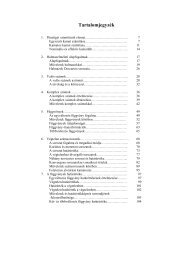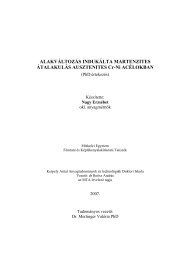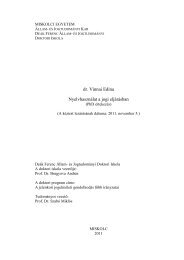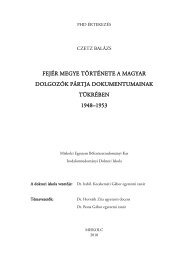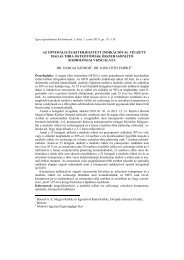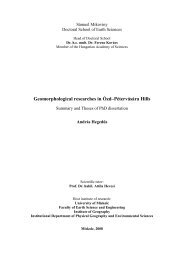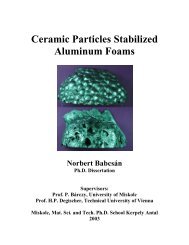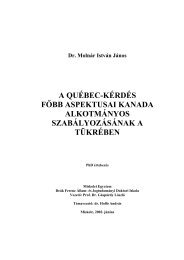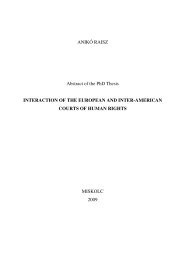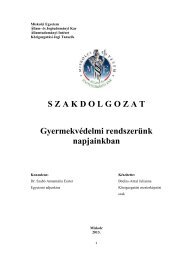- Page 1 and 2:
PhD ÉRTEKEZÉSdr. jur. Raisz Anik
- Page 4 and 5:
III.1. Az élethez való jog.......
- Page 6 and 7:
Rövidítések jegyzékeAÁSZ Organ
- Page 8:
BevezetésA világ tavaly ünnepelt
- Page 12 and 13:
is azok bíróságai - főként azo
- Page 14 and 15:
amely latin-amerikai és észak-ame
- Page 16 and 17:
szociális alapelvek deklarációja
- Page 18 and 19:
Az AÁSZ Charta 29 több ponton is
- Page 20 and 21:
Egyezményét. 74. cikke (2) bekezd
- Page 22 and 23:
hét esztendővel ezelőtt az EJABi
- Page 24 and 25:
amnesztiatörvények, 61 vagy a bel
- Page 26:
I.2. Az interakció általábanI.2.
- Page 29 and 30:
I.2.2. Nemzetközi bírói fórumok
- Page 31 and 32:
Ngudjolo Chui ügyek). 93 De a Nemz
- Page 33 and 34:
Ahogy említettem, elegendőnek tar
- Page 35 and 36:
Nemzetközi Bíróság 113 példáu
- Page 37 and 38:
Királyság 127 vagy legutóbb az A
- Page 39 and 40:
dolgozat keretei között sajnos ne
- Page 41 and 42:
E kis számnak oka lehet maga az Eu
- Page 43 and 44:
megválaszolása. Egyhangúlag elut
- Page 45 and 46:
tekintetében szabad kezet adott az
- Page 47 and 48:
valamelyikében - alkalmazandó. E
- Page 49 and 50:
endelkezéseivel. A kérdés lénye
- Page 51 and 52:
A tizenhatodik tanácsadó vélemé
- Page 53 and 54:
cikkével. 197 Ahogy az Amerikaköz
- Page 55 and 56:
sérülékeny helyzetére hivatkozv
- Page 57 and 58:
több, mint felében kifejezetten u
- Page 59 and 60:
némileg eltér az európai gyakorl
- Page 61 and 62:
azaz miért is hivatkozik és mikor
- Page 63 and 64:
egyezményben vállalt kötelezetts
- Page 65 and 66:
„élő jogot” képeznek, amelye
- Page 67 and 68:
Az állam védelmi kötelezettsége
- Page 69 and 70:
iztosítani. 313 Az Amerikaközi B
- Page 71 and 72:
írája közül e dolgozat írásak
- Page 73 and 74:
látható, az EJEB tanácsadó vél
- Page 75 and 76:
II.2. Ideiglenes intézkedésekAz i
- Page 77 and 78:
ámutathatunk. E kötelező erő ug
- Page 79 and 80:
Mexikó kérésére született. 348
- Page 81 and 82:
Az európai emberi jogvédelmi rend
- Page 83 and 84:
amelynek fennállta esetén az EJEB
- Page 85 and 86:
II.2.2.2. Ideiglenes intézkedések
- Page 87 and 88:
állampolgárságú - személy el s
- Page 89 and 90:
Habár annak kivételes jellegét l
- Page 91 and 92:
jog” („living instrument”) é
- Page 93 and 94:
Az ideiglenes intézkedések kötel
- Page 95 and 96:
Ezt az álláspontot megerősített
- Page 97 and 98:
intézkedést ugyanis állítólago
- Page 99 and 100:
különvéleményét, amely határo
- Page 101 and 102:
Az Amerikaközi Bíróság intézke
- Page 103 and 104:
Ha átfogóan tekintünk az ideigle
- Page 105 and 106:
ocsáthatna ki kötelező ideiglene
- Page 107 and 108:
intézkedéseket illetve ítéletek
- Page 109 and 110:
elkövetkezendőkben az Amerikaköz
- Page 111 and 112:
elképzelhetetlennek, hogy az elkö
- Page 113 and 114:
Trindade bíró itt különösen az
- Page 115 and 116:
II.3. Az áldozatok eljárásjogi h
- Page 117 and 118:
tekintem a vizsgálatom alapjának)
- Page 119 and 120:
az Amerikaközi Bizottság jelenté
- Page 121 and 122:
Habár minden bizonnyal érdekes le
- Page 123 and 124:
jóvátétel, tényfeltárás, tár
- Page 125 and 126:
esetben ítéli meg a pénzbeli el
- Page 127 and 128:
előforduló „proyecto de vida”
- Page 129 and 130:
szegmensét, a bennszülöttekkel k
- Page 131 and 132:
homine elv alapján, 589 különleg
- Page 133 and 134:
Cançado Trindade bírónak a Blake
- Page 135 and 136:
dollárnyi kártérítést, ezenfel
- Page 137 and 138:
útról, amely ékes bizonyítéká
- Page 139 and 140:
A Serrano-Cruz nővérek ügyében
- Page 141 and 142:
Ugyanakkor már az 1960-as évektő
- Page 143 and 144:
Oroszországot és Lengyelországot
- Page 145 and 146:
Összefoglalóan tehát megállapí
- Page 147 and 148:
a két bíróság ezirányú ítél
- Page 149 and 150:
véleménynek 1983-ból. A (nemcsak
- Page 151 and 152:
jogsértés rendelhető az élethez
- Page 153 and 154:
származású szökött katona, rá
- Page 155 and 156:
felrobbantották ugyanis azt az ép
- Page 157 and 158:
felelősségrevonását olyan szem
- Page 159 and 160: A Blake-ügyben az Amerikaközi Bí
- Page 161 and 162: volna fogadniuk külön a joghatós
- Page 163 and 164: sokat merít az európai és amerik
- Page 165 and 166: Ugyanakkor meglepő, hogy az Amerik
- Page 167 and 168: Bilgin, 798 Kiliç-, 799 Mahmut Kay
- Page 169 and 170: Az ölési szándékra, illetőleg
- Page 171 and 172: PKK-fegyveresek lettek volna jelen,
- Page 173 and 174: helyzet elmélete révén még nagy
- Page 175 and 176: Ugyanez 850 az amerikaközi esetjog
- Page 177 and 178: kapcsán a közvetlen jogsértés
- Page 179 and 180: Különösen az élethez való jog
- Page 181 and 182: III.2.1. Az Emberi Jogok Európai B
- Page 183 and 184: miután ez nem használt, azzal fen
- Page 185 and 186: magasabb szintű védelme érdekéb
- Page 187 and 188: Szintén a fenti axióma jelent meg
- Page 189 and 190: Mindazonáltal többségében az EJ
- Page 191 and 192: Ami a személyes szabadsághoz val
- Page 193 and 194: jogára. 954 Előkerült az az eur
- Page 195 and 196: megállapításokat, például az I
- Page 197 and 198: összecsapásában meghalt (utóbbi
- Page 199 and 200: kontra Trinidad és Tobago ügyben
- Page 201 and 202: létezik. Álláspontom szerint min
- Page 203 and 204: alappal (eltérő területi hatáll
- Page 205 and 206: hangsúlyozták, kidolgozva annak l
- Page 207 and 208: ÖsszefoglalóAz értekezés az emb
- Page 209: kérdését. A harmadik rész az an
- Page 213 and 214: IRODALOMJEGYZÉKAAKEN, Anne van: Ma
- Page 215 and 216: BENOÎT-ROHMER, Florence : Les pers
- Page 217 and 218: Studies Revisited. University of Ne
- Page 219 and 220: CANÇADO TRINDADE, Antonio Augusto:
- Page 221 and 222: CHOLEWINSKI, Ryszard: The Human and
- Page 223 and 224: DREIER, John C.: The Organization o
- Page 225 and 226: Human Rights, Studies in Honour of
- Page 227 and 228: JAMISON, Melissa A.: The Sins of th
- Page 229 and 230: Expression and Access to Informatio
- Page 231 and 232: l’homme aux niveau international,
- Page 233 and 234: ORENTLICHER, Diane F.: Settling acc
- Page 235 and 236: Thomas Buergenthal. Insituto Intera
- Page 237 and 238: SOHN, Louis B.: The New Internation
- Page 239 and 240: UERPMANN-WITTZACK, Robert: Personal
- Page 241 and 242: A szerző kapcsolódó publikáció
- Page 243 and 244: Bazorkina kontra Oroszország, 2006
- Page 245 and 246: Keenan kontra Egyesült Királyság
- Page 247 and 248: Sunday Times kontra Egyesült Kirá
- Page 249 and 250: Caesar kontra Trinidad és Tobago,
- Page 251 and 252: Los Niños y Adolescentes Privados
- Page 253 and 254: Valle-Jaramillo és társai kontra



